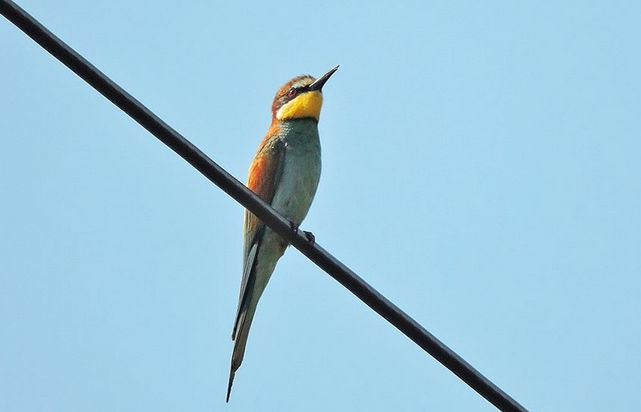Just last month chicks from a pair of Marsh Harriers hatched on the RSPB reserve in Brading. Now we have confirmation from the National Trust of another pair of rare birds who have made the Island their home. This from the National Trust in their own words. Ed
The Wydcombe Estate on the Isle of Wight has become home to a pair of rare bee-eater birds which are only the third on record to breed successfully in the UK in the last century.
It’s been over a decade since the colourful birds, which normally nest in southern Europe, were last recorded breeding in the UK.
A pair successfully fledged two young from their nest in a quarry in County Durham in 2002 and in 1955 two pairs of bee-eaters raised seven young between them in Sussex.
In the sandy hills of the Wydcombe Estate
The latest pair of bee-eaters to breed on our shores chose a small valley in the sandy hills of the Wydcombe Estate on the south of the island to nest. Here the soft ground, rolling landscape and a stream provided the ideal conditions for their nest burrow, which could be up to three metres long.
Caring for the birds
As the unhatched eggs of these rare visitors could be a potential target for egg thieves we’re watching the nesting site around the clock. Our volunteers and staff have been working with the RSPB and the Isle of Wight Ornithological Group to keep the birds safe.
But you can still see this rare nesting event from a designated public viewing point overlooking the birds’ favourite feeding area. The spot has been chosen to offer the best possible sightings of the exotic-looking birds – renowned for their kaleidoscopic plumage – while protecting their welfare.
Waiting for the chicks
The birds’ arrival is causing quite a stir.
Our nature and wildlife expert Matthew Oates said,
“The bee-eater is arguably the most stunning bird on the British list; it looks tropical. We’re pulling out all the stops to help the chicks safely fledge, whilst keeping the public up-to-date with their progress.”
The adult birds have been spotted delivering food into the nest suggesting that the eggs have already hatched. The chicks won’t leave their underground nest site for about another fortnight, so the number of chicks still isn’t known, but bee-eaters traditionally lay clutches of four to nine eggs.
Perfect conditions for bee-eaters
Hot temperatures since the spring have helped attract above average numbers of bee-eaters to the UK this year, with ten seen along the south coast since May.
Matthew said,
“As our climate changes it’s likely that we’ll see increasing numbers of new visitors on our shores.”
The Isle of Wight has proved to be the perfect location for this particular pair.
Our ranger Ian Ridlett added,
“With rising temperatures, the varied landscape and bountiful supply of insects on the Wydcombe Estate was obviously enough to tempt the bee-eaters to nest here.”
Ian will be posting news of the bee-eater family’s progress on our Isle of Wight Facebook page.
Image: © National Trust





